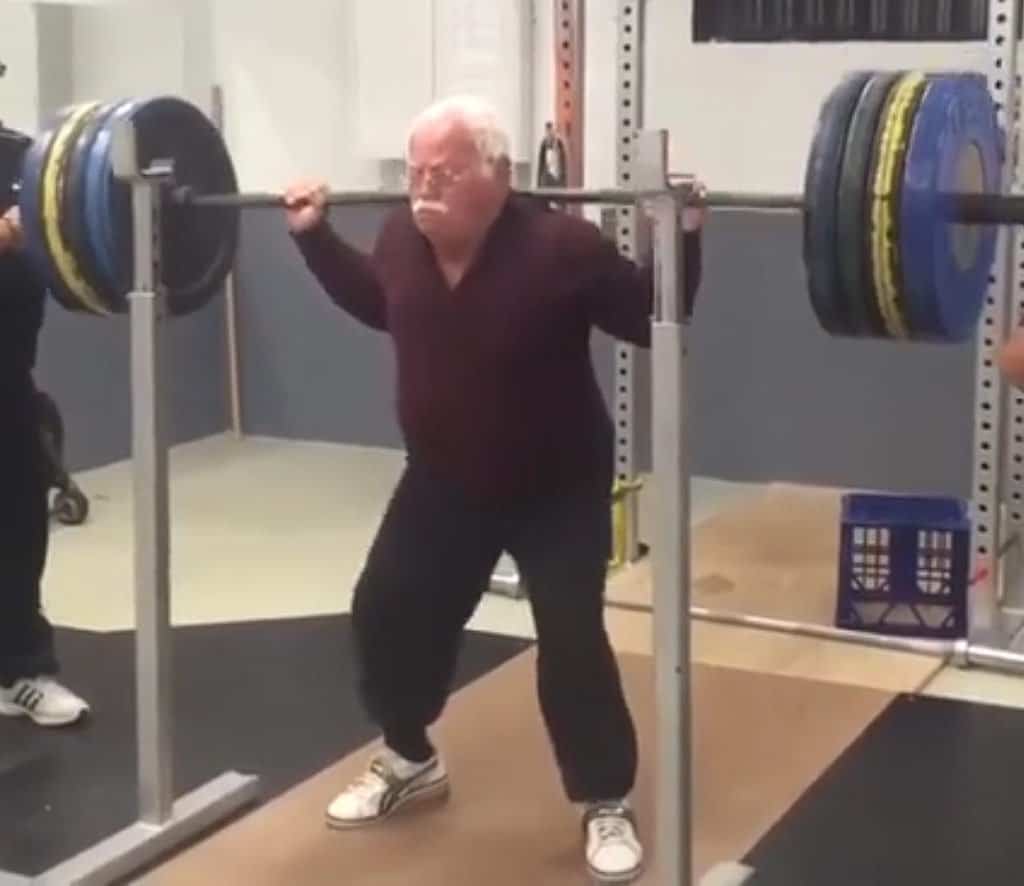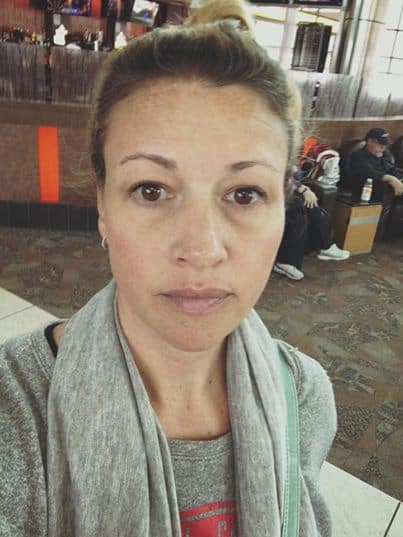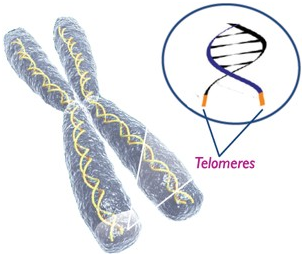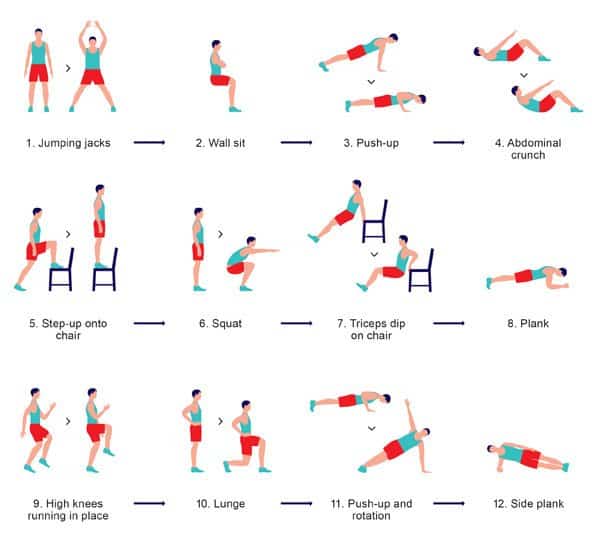3 Expert-approved Anti-aging Exercise Routines You Can Do and Why You Should Bother
It’s been my experience, and now the science affirms, that no one thing does as much to improve the quality and robustness of life as certain anti-aging exercise routines that you can start right now. Here’s why you should bother…

WHAT DOES exercise have to do with living longer and healthier, so that you don’t live your last two decades of life hobbling along all achy-like and chubby and bent over as you stumble toward the grave.
Glad you asked.
Here’s the bottom line:
Exercise is about the most important single thing that you can do all by yourself (though it’s better with a buddy) that can help you age dramatcially better.
In this article, you’ll discover:
- What does skin have to do with aging well?
- How anti-aging exercise slows down the aging process and improves the quality of life.
- Anti-aging exercise programs that you can begin right now.
- And don’t forget to sleep – it may decelerate aging in the brain.
Let’s begin with what exercise doesn’t do, because this is a very short list. Exercise will not do much to make your face look younger. If you struggle with the relative importance of looking – rather than being – younger than you are, reflect on a recent viral event stimulated by one women’s reaction to a skin lotion salesman.
What Does Skin Have to Do With Aging well?
This happened earlier in the week and it created quite a stir. After the confrontation went viral, various news outlets, like US Weekly, reported a story about Annick Robinson’s confrontation with an aggressive salesperson who strongly pitched her on the necessity of using his anti-wrinkle cream to avoid having plastic surgery later in life.
She demurred, and it was what she said and how she handled the scathing sales pitch that gave this story its viral boost.
Here’s how the wrestling match between Annick Robinson and the salesguy went, as she remembered it and revealed on her Facebook page, according to US Weekly:
Salesman: “Your skin is so natural looking, you aren’t wearing any makeup, right?”
Robinson: “I look my age and that’s OK, actually.”
Salesman: [Unsure how to handle that] “Let me show you our face serum, because if you aren’t careful to maintain your skin now, these wrinkles on your face will get much deeper; by 45, creams won’t help anymore.”
Robinson: “What’s wrong with a woman looking 40?”
Salesman: “Well, let’s talk about the bags under your eyes, and smile lines — my eye cream could improve those in 15 minutes.”
Robinson: “What’s wrong with my eyes? I have a miracle baby at home and haven’t slept in two years, so if I have bags, I am grateful to have them, and my husband and I laugh a lot. Those are his fault. He loves how I look … I don’t think I need your cream.”
Salesman: [Nervously] “They may be manageable now, but by 50, it’s too late to correct sagging skin and deep wrinkles; unless you act now, only surgery can correct those.”
Robinson: “What’s wrong again with a woman aging? You know, my husband and I can’t wait to grow old together, we talk about it all the time, how we’ll be this funny wrinkled old couple. My husband is going to age too, we all are. It’s kind of how life works.”
Salesman: [Glancing nervously at other customers in the store who are listening in] “Wait, if it’s the price that’s an issue, I can offer you our special this week: all three creams for $199 — that’s cheaper than Botox!”
Robinson: “I look fine now, and when I’m 45, I will look fine, and when I’m 50, I will look fine, because there is nothing wrong with a woman aging. Old age is a privilege denied to many, and I don’t appreciate you marketing youth instead of your products, and denigrating aging women as a sales tactic. Thank you, but I don’t want or need your cream.”
Let’s give Mrs. Robinson a high five for that exchange!
The reason I shared this with you is not to underscore some displeasure with face creams, ointments, serums and the like that may improve how one looks. As I wrote in Your Battleplan to Combat Aging Skin, some such stuff might help improve the look of facial skin, presuming that one is healthy overall. Nothing applied to the skin can overwhelm bad habits such as eating lots of sugar, unhealthy fat, copious amounts of high glycemic carbs and never breaking a sweat, combined with the potential manifestations of such habits like hormone disequilibrium, poor detoxification mechanisms, harmful gut bacteria and obesity.
Although it would be great to look young, far more important is that you function as youthfully as you can irrespective of your chronicle age. What I mean by this is to sufficiently improve your mindset, diet, hormonal balance, gut bacteria, detoxification mechanisms, skeletal muscle, functional fitness and mobility that you actually (measurably) become biologically younger.
How Anti-aging Exercise Slows Down the Aging Process and Improves the Quality of Life
Frankly, it takes a comprehensive effort to turn the clock back, which is why I’m writing a book about it. That said, there are some things you can do that have a multi-system beneficial effect on the aging process, and perhaps the best of them is exercise, as in adopting a specific anti-aging exercise program.
(Yawn.)
Yeah, OK, you’ve heard that before, and perhaps either you’re someone whose been a life-long exerciser (off and on) and feel there’s nothing more to be learned, or you’re dead set against taxing your poor delicate self by moving with more vigor than it takes to get from the couch to the car.
To the lifelong exerciser I say read on because you want to ensure that the type of exercises you’re doing maximizes the benefits to you. To the desk warrior I say read on because – miracle of miracles – there just might be some inducement you’re about to bump into that might stimulate a bit of consistent movement, especially if you grab a friend to help you along. (The “Buddy System” results in much higher compliance than doing it alone.)
Here’s what you can expect when you exercise regularly, particularly if you do resistance training:
- You’ll re-ignite your metabolism, reprogramming your body so you can readily start burning fat right away.
- You’ll reboot your endocrine system, creating a resurgence of youth enhancing hormones so can get infinitely more energy—and replace flab with lean, strong muscle while boosting your sex drive.
- You’ll fortify your body by regaining bone density, muscle and building a solid foundation.
- You’ll boost your brain power, enhancing memory and improving your cognitive function making you as sharp as a tack.
- You’ll dramatically decelerate your body’s aging process, such that your biological age will age slower than your chronological age—making you look and feel younger with each year that passes.
Let’s start with muscle and strength, the obvious results gained by a consistent, properly executed exercise program.
Exercise Builds Muscle
As we age, muscle tends to either wither away or turn to fat. This muscle loss (called “sarcopenia”) is not just a side effect of disease and frailty, the inevitable companions of aging, but also a prime cause. Insufficient muscle contributes to imbalance and falling, metabolic dysfunction, cognitive decline, hormonal imbalances and more.
We’re not talking bulging bodybuilder muscles, but enough muscle to make you functionally fit, and that means having sufficient muscle and the strength it affords to move, push and pull your bodyweight. You don’t need to do 10 chin ups, but one should be doable. You don’t need to do 20 push ups, but women should be able to do a couple, and men, 10. And you don’t need to be able to run a mile in six minutes, but how about being able to walk up a mile-long hill in 15 to 18 minutes.
If you could care less about moving your body around because your car does that well enough, consider that muscle can also keep you alive, something useful, yes?
As we age, muscle fibers begin to perform less ably and we lose muscle mass, leading to unhappy consequences unless we do resistance training type exercises shown below.
“As men age, they can lose five to seven pounds of muscle mass every 10 years starting in their 30s, and more as they approach their 50s,” says Wayne Westcott, Ph.D., professor of exercise science at Quincy College, researcher, and author of more than 20 books on strength training. “They also gain about 10 pounds over the same time frame.” Now, some math: If you go down five or so in muscle, but up 10 overall— that’s 15-plus pounds of fat gained each decade. (1)
I mentioned falling. There’s a direct relationship between muscle mass and falling in the elderly. Older people who fall and break a bone and are thereby bedridden for weeks will lose even more muscle and bone mass, which helps explain why 33% of people who fracture their hip in the UK die within 12 months. (2) This is a situation that is so dire that according to WebMD, 80% of women surveyed would rather be dead than in a nursing home as a result of falling and breaking a hip. (2)
That won’t be you, you say — falling is for inattentive teeter-totters. How about eating; do you do that? If so, know that healthy muscle tissue is a major user of blood glucose, which is a type of sugar primarily obtained from ingesting carbohydrates that supplies energy to all the cells in our bodies. If your body doesn’t cope well with the inevitable post-meal blood sugar surge, it can result in type 2 diabetes. Which is why Dr. Daniel More from the University of Toronto says:
“People think of muscle as the body’s mover, but it’s really a huge metabolic organ,” (3)
Exercise Assists Detoxification
Most people don’t do anything intentionally to aid their body’s natural detoxification mechanisms, and have no intention to do so, but if you regularly exercise you’re helping your body excrete its toxic load.
In Do These 2 Anti-aging Pills Really Work, I examined, among other things, the role autophagy plays in aging and aging-related disease. In the article, I quoted longevity expert Dr. James Watson’s explanation of what is Autophagy:
“Autophagy is like having a Pac man inside each of your cells that chases down, consumes and recycles dysfunctional organelles, proteins and protein aggregates.” (4)
Another longevity expert, Dr. Anna Maria Cuervo of the Albert Einstein College of Medicine, reviewed the genetic evidence in support of tight connections between autophagy, health span and aging.
She made these observations about autophagy and age-related disorders (5):
- The age-related decline in autophagic activity will affect normal cell function and contribute to different aspects of how aging manifests.
- Two neurodegenerative disorders of highest prevalence in our society — Alzheimer’s and Parkinson’s disease — are both late-onset disease that are coincident with the functional decline of the different autophagic pathways.
- By removing damaged organelles and reducing chromosome instability, autophagy acts in tumor suppression; therefore, when it decreases with age, accumulation of intracellular damage, dysfunctional organelles and chromosome aberrations increases the chances of cancerous cells forming and propagating.
- Different aspects of the gradual deterioration of the immune system with age could be related to autophagic dysfunction, particularly affecting dendritic cells, macrophages and B-cells.
- Defective autophagosome clearance in the aging muscle could contribute to muscle wasting (sarcopenia) characteristics of old organisms (like us).
What does this have to do with exercise, you ask?
Scientists found that the rate at which the mice were healthily demolishing their own cells drastically increased after they ran for 30 minutes on a treadmill. The rate continued increasing until they’d been running for 80 minutes.
Ah, but you’re not a mouse, I know. Humans are harder to study, and so finding out the exercise intensity and duration to reliably stimulate autophagy is tough to do. That said, one researcher in the mouse study was convinced enough by the results to buy his own treadmill.
Really.
Exercise Reduces Inflammation
It’s now common knowledge among medical types that inflammation plays a significant role in causing or aggravating many chronic diseases, and even the aging process itself. You can do much to reduce chronic inflammation by eating an anti-inflammation diet, like the one advocated by famed functional medicine doctor Andrew Weil. It’s also helpful to take supplements containing ingredients like curcumin, fish oil and various herbal compounds blended in Zyflamed.
Not to mention, exercise!
Research shows that regular physical activity can reduce the inflammation in the body, and by so doing decrease your risk of developing related diseases and conditions—like heart disease, depression, decreased mental function, and loss of muscle mass.
Although other research has already shown that exercise has anti-inflammatory potential, a new study published in the journal Circulation followed people for 10 years to examine the long-term effects. They found that, in general, people who were more active at the start of the study, or exercised more by the end, had lower levels of inflammation.
You want a younger, healthier body? Reduce your inflammation.
Exercise Improves Cellular Lifespan
There are plenty of reasons to exercise, and in this article I’ve highlighted a few, but the effect that regular activity may have on cellular aging could turn out to be the most profound. Some years ago, Gretchen Reynolds wrote an article for the NY Times about a study that shows how exercising keeps your cells young. It was eye opening!
The scientists examined several groups of men and women of different stripes:
- The young and sedentary;
- The middle-aged and sedentary;
- Professional runners in their 20s; and
- Serious middle-aged runners.
The white blood cells were examined in all participants to determine telomere size. Telomeres are tiny “caps” at the end of DNA strands, the length of which might predict lifespan. With each succeeding cell divison, a small portion of telomeres is “cut” away, leaving them shorter than before. (See my article, Three Months to Longer life.)
Those telomeres in the cells of both the active and slothful young adults were of similar size, which was unsurprising since none of them had been alive long enough for multiple cell divisions to have snipped away at their telomeres.
It was a different story for the middle-aged cohort. When the researchers measured their telomeres they discovered that the sedentary older subjects had telomeres that were on average 40% shorter than in the sedentary young subjects. This could be expected given that – all other things being equal – telomeres shorten with age. However, the middle-aged runners had remarkably youthful telomeres; only about 10% a bit shorter than those in the young runners!
Overall, telomere loss was reduced by approximately 75% in the aging runners, or as Dr. Werner, the lead researcher said:
‘‘[exercise] at the molecular level has an anti-aging effect.’’ (6)
Exercises For A Longer, Stronger Life
Now that you know why you need to exercise to avoid the ravages of aging that most people experience, it’s time to take a look at three expert-approved exercise routines. After the look, schedule the do.
#1 Built your own routine
Choose among the the following exercises to build your 10-exercise workout: (7)
- One squat exercise, such as goblet squat, back-loaded squat, or split squat (both sides)
- One lunge exercise, such as lateral, reverse, or front lunges
- Two upper-body “pull” exercises, such as standing one-arm cable row or bentover rows, pullups or lat pulldowns
- Two upper-body “push” exercises, such as standing two-arm cable chest press or bench press, overhead shoulder press or military press
- One arc exercise, such as chest or reverse fly, or lateral raise
- One arm curl exercise, such as concentration, hammer, or preacher curls
- One arm extension exercise, such as triceps kickbacks, pressdowns, or overhead extension
- One functional core exercise, such as woodchops, reverse woodchops, or med ball slams
You only need to perform one set of functional core exercises, as the core is engaged throughout the workout.
#2 Follow this 15-minute circuit
If you need a quick exercise program, consider this 15-minute anti-aging circuit video produced by good folk at The Feelgood Plan. Each round is one minute long:
Here’s a list of the exercises in the video, along with my comments:
| Exercise | Commentary |
| 1. Reverse lunge | Try to ensure that your shin of the bent leg is perpendicular to the floor. |
| 2. T-bird | Men might want to load the arms with a book or light dumb bells. |
| 3. Squat salutation | Try to place your weight onto your heels and gradually squat lower. You can also come up on your toes when standing up to work the calves. |
| 4. Stairway to heaven | The lower the support (all the way to the floor) the harder the exercise. |
| 5. Step-up | Begin with a step height that will allow you to do this sequence. As you get stronger, increase the height. |
| 6. Single leg lowering | The key here is to focus on flattening your lower back to the floor and holding it there. Beginners might simple flatten and hold their legs aloft till strength is gained. |
| 7. Stork stance | You can catch your breath during this one. If you don’t need to do that, just do it once at the end of the routine. |
| 8. Reverse lunge | 8 thru 14 are repeats. |
| 9. T-bird | |
| 10. Squat salutation | |
| 11. Stairway to heaven | |
| 12. Step-up | |
| 13. Single leg lowering | |
| 14. Stork stance | |
| 15. The finisher: no-hands stand-up | This one requires as much flexibility as it does strength. Try doing it in an open doorway where you can grab the sides of it to help you stand up. |
#3 A 7-minute routine for the time-challenged
If you need a quicker exercise program, consider this 7-minute workout: (8)
Deep Sleep, Deep Thoughts
I leave you with this: Get some sleep.
A new study found that men who chronically skimp on sleep show signs of accelerated aging in the brain, but it’s probably as true for women. This was reported in Men’s Health, which said:
We already know that inadequate sleep is associated with poor performance and concentration; that there’s a relation between sleep and many health issues; and that change in sleep duration over a similar five-year period is associated with an increase in premature death.
All that muscle you’ll be breaking down (the catabolic phase) will need to be built up again, ever stronger (anabolic phase), and deep, restful sleep is very necessary for that to happen.
Go get em tiger!
Oh, about that picture at the top. It’s an 84 year-old man squatting about 330 pounds; see:
Last Updated on April 11, 2023 by Joe Garma






